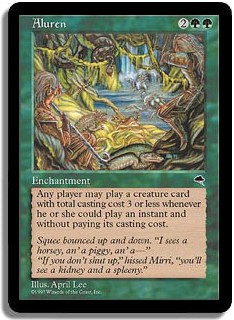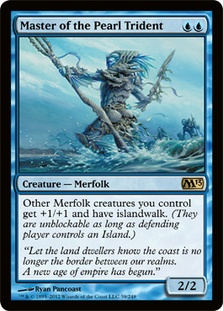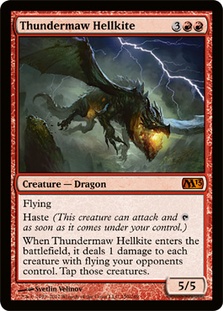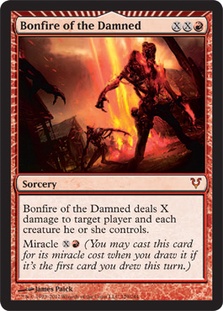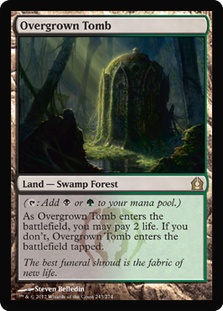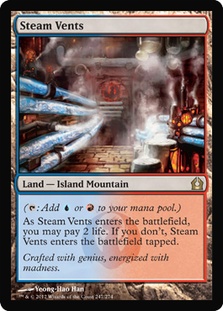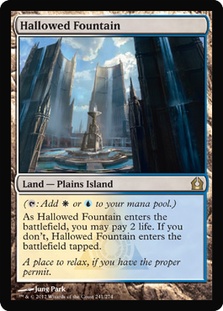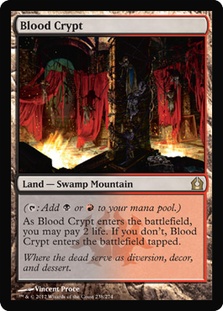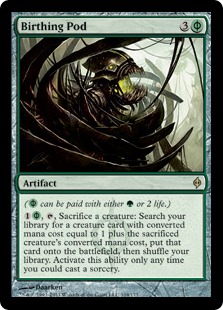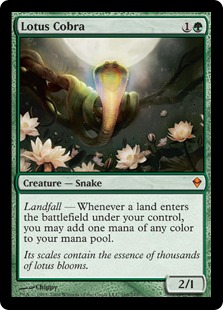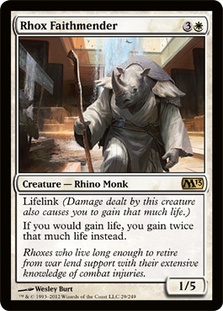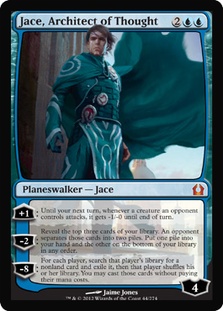Most days, I like to analyze the game of Magic from the top down. I’m a big picture sort of guy, always worrying about the far future and what cards are going to still be valuable years down the line. Today, though, I’d like to get back to basics and talk about a couple of cards that have been making waves recently. Sometimes, narrowing one’s focus is the best way to make money.
Deathrite Shaman
Each Magic set is most strongly remembered via a handful of its most valuable and influential cards. For example, Worldwake is the Jace and Stoneforge Mystic set. Future Sight is the Tarmogoyf set. Ravnica: City of Guilds is the shockland, Dark Confidant, and (yes really) Doubling Season set.
Once the dust settles, I expect that Deathrite Shaman will be among the top two or three enduring and influential cards in Return to Ravnica. In fact, this is probably true already.
Consider the following finishes over the past couple of months:
10/21/12 – Michael McDermott wins a SCG Legacy Invitational Qualifier with Zombies. It has 4x Deathrite Shaman in the maindeck.
11/4/12 – Jeremy Dezani wins a Modern Grand Prix with Jund. It has 4x Deathrite Shaman in the maindeck.
11/11/12 – Jacob Wilson wins a Modern GP with Jund. It has 4x Deathrite Shaman in the maindeck.
11/18/12 – Martin Juza wins a Standard GP with Craterhoof Ramp. It has 4x Deathrite Shaman in the maindeck.
11/18/12 – Matt Pavlic finishes second in a SCG Legacy Open with Junk. It has 3x Deathrite Shaman in the maindeck.
12/2/12 – Daniel Signorini finishes second in a SCG Legacy Open with BUG Delver. It has 3x Deathrite Shaman in the maindeck.
12/9/12 – Willy Edel wins a Modern GP with Jund. It has 4x Deathrite Shaman in the maindeck.
12/9/12 – Sam Pardee finishes second in a Modern GP with Melira Pod. It has 2x Deathrite Shaman in the maindeck.
I could keep going. Deathrite Shaman is the rare beast of a card that has proven itself in a variety of strategies in all three major formats. It’s powerful enough to take down Legacy tournaments and versatile enough to show up in many different builds. This is a legitimate tier 1 Eternal card, and you should be treating it as such.
Want more proof? The foreign and foil community are already all over it. Check out what this foil Korean copy sold for on eBay:

It is also important to realize that we’ve made it to the part of the year where it makes sense to start buying Return to Ravnica singles for the long haul. Unlike the past few years, we’re going to stop drafting the fall set for several months while Gatecrash steals the spotlight. Even though Return to Ravnica was opened in huge numbers, the supply of singles is going to fall off dramatically.
Not only will Deathrite Shaman go up in the short term, but I don’t expect it will drop much on rotation. Cards like this that are heavily played in Eternal tend not to experience much of a drop off.
Deathrite Shaman retails for $10 right now. The reason this number isn’t higher is because all of the other amazing cards in the set are keeping the price low. Once the supply starts to dwindle—and especially when the set goes out of print—this card will likely soar in value. I feel relatively confident projecting it as a $15 card over the next year and a $20 card after that.
Lotleth Troll
From a high of $12, Lotleth Troll is down to just $4 as of the first of December. Unlike Deathrite Shaman, this card hasn’t appeared in too many winning decks lately. The last deck I saw with this card that makes any sense was Ethan Price’s Junk Reanimator from the SCG IQ on Veteran’s Day, but more recent builds have mostly ignored the Troll. The B/G Zombies deck didn’t seem to materialize, either—Knight of Infamy and Blood Artist (depending on the build) have been holding down the two-drop slot, and red provides a far better range of four and five-drops than green.
This card also hasn’t really broken in to any of the Eternal formats, so I doubt the free fall will stop now. Lotleth Troll still has a very high power level, so there’s a chance this card will take off at some point in the future, but for now I expect it will keep dropping.
Aluren
Last Monday, the question of what happened to Aluren dominated Twitter. For those unaware, here’s the Black Lotus Project price chart for the card from the beginning of 2009 through the end of 2012:
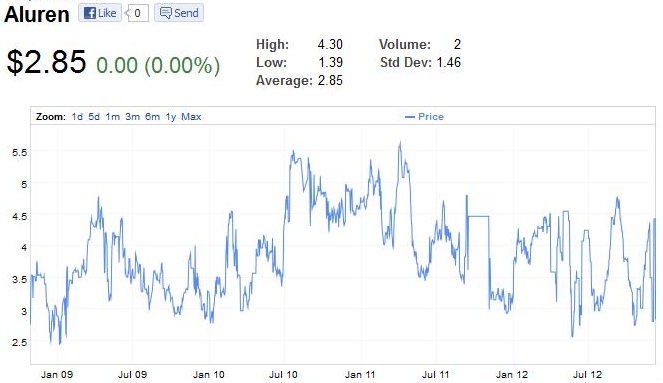
That’s a pretty ho-hum chart, showing a slight oscillation in price between $2.50 and $5.50 depending on how hot the Legacy market is at the moment. The reason the card has stayed so low despite being an Eternal playable combo piece is that it is only really playable in one tier 1 deck and that deck requires Imperial Recruiter to function. Imperial Recruiter is a $300 card. Thus, the demand for Aluren has never been all that high.
Last week, though, the retail price for the card jumped from $5 to $15. What happened?
The truth is that I don’t know. My best guess is that a speculator or store saw an opportunity to corner the market on a rare that is uniquely positioned for such a thing. After all, how many rares are maindeckable in Legacy, on the reserved list, and worth $5 or less? It’s possible that someone just decided to force the issue.
My other thought is that someone is speculating (or has inside knowledge) about a possible Imperial Recruiter reprint. This card seems like it could make a decent Judge foil without tanking the value too much, and it would certainly allow people access to the deck. Such a reprinting would likely make Aluren a $20 card overnight based on increased demand. It’s possible that a person or store decided to hoard copies of the card in preparation.
What does this mean for you? Well, your chance to find cheap copies of Aluren online is probably over. If you have any lying around that you’d like to get rid of, I’d suggest putting them in your book and trying to get someone to make a move on them at retail thanks to the increased hype and attention surrounding the card. Even though the price for Aluren has risen, people still can’t actually build the deck without Imperial Recruiter.
Even if someone has just cornered the market because they wanted to, I doubt the card will maintain a $15 price tag for long. Chances are that Aluren will start slowly dropping in price again—and soon. If you ever do hear about a confirmed Recruiter reprint, though, buy copies of Aluren as fast as you can. The initial swing of hype and excitement will probably drive the card up over $30 overnight, though it won’t stay there unless the deck puts up consistent results. That would be a case similar to the Land Tax unbanning where I’d look to buy in quick and sell out even quicker.
Master of the Pearl Trident
This is one of the cards I was lowest on when M13 came out, but I love it as a spec opportunity now.
To refresh your memory, Master of the Pearl Trident debuted at $5 and immediately shot up to $6. It stayed in the $5-$6 range for a couple months, but by mid-November it was down to $2 here on SCG. Merfolk has been frozen out of Modern, it has never showed up in Standard, and its star is on the wane in Legacy.
That is why it’s a great time to buy. Throughout the history of Magic, Merfolk have been generally pretty good and have always been very popular. If the deck ever sneaks in to Modern or Legacy, this card should shoot back up to the $5 or $6 range easily.
Of course, the real play with these is coming up in just a few months. The Simic guild will be chock full of Merfolk, and chances are some of them will look Standard playable. Even if the deck never materializes, demand for this card should skyrocket during the hype and preorder period. There’s ample chance to pick these up for next to nothing right now and trade them for good Standard cards in a few months. Personally, I bought several dozen of these in anticipation, but Simic is my favorite guild by a wide margin so I am rather biased.
Thundermaw Hellkite
No card in Standard is soaring quite as high right now as Thundermaw Hellkite. At the GP in Japan, it was selling for over $50 on site. Even though the price didn’t get that high Stateside—availability bubbles at large events tend to be localized—the retail price of the card jumped from $30 to $40.
Is it worth it?
Let me start by saying how much I love this card. It was one of only a couple rares I was really high on in M13, and I predicted it would go from $20 to $30 by the release of Return to Ravnica. (In reality, it hit $30 long before that, dropped to $13 by the release of Ravnica, and then jumped back up again. Taken literally, my prediction was way off.)
Even still, I’d be more skeptical about Thundermaw Hellkite’s price jump if the card wasn’t putting up results. Instead, the Dragon seems to keep finding his way into more and more decks. Most of the B/R and Mono0Red lists that have been doing well over the past few weeks have used this guy, and he’s even started showing up in Modern.
In addition, no one is opening M13 anymore. While I fully expect Thundermaw Hellkite to get a reprint in M14 (Baneslayer and the Titans each got two years), we’re still seven months away from the release of that set. A $40 price tag in the interim seems pretty reasonable.
That said, the ceiling on this card is $50. The floor, as we’ve already learned, is $13. It can drop a lot farther than it can rise. If you can get someone to give you $40 in trade for the card and you aren’t using it in a deck, feel free to lock that value in now.
Bonfire of the Damned
Bonfire of the Damned has finished its long drop from $50 to $25, a price it has been sitting at for almost a month now. After a summer where it seemed like you couldn’t go a day without hearing someone gripe about the price of this card, it is now cheaper than Tamiyo and Snapcaster Mage.
This would be reasonable if Bonfire of the Damned had stopped seeing much play. That isn’t the case anymore, though. At SCG Standard Open: Las Vegas last weekend, four of the decks in the Top 8—including the first and second place decks—ran Bonfire.
Check out this chart of the card’s price:
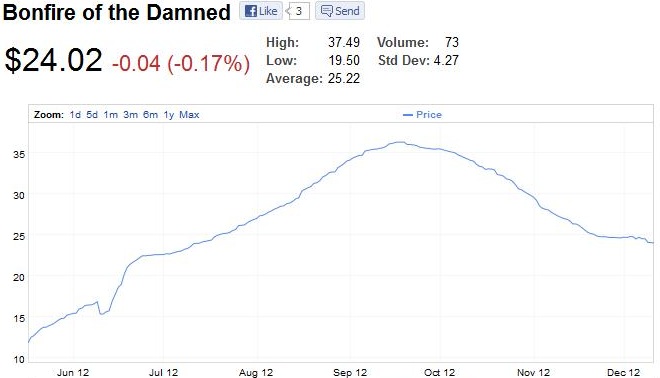
Two things jump out at me. First, there’s no upward trend starting yet. Even though the card is seeing a lot more play now, the price has continued to erode. I’m pretty sure that this will change after the holidays—especially when Boros and Gruul cards start to get spoiled.
Second, the average eBay price is only about $1 off from the SCG retail price. This is very rare when dealing with expensive mythics, especially Standard cards. This tells me that once the demand starts to increase again—and it will—the retail price has a TON of room to rise and almost no room to fall.
I would target Bonfire hard in trades at $25, especially if you can trade other cards at full retail for them. Your risk is low even though the price is high.
Return to Ravnica Shocklands
While most Standard players already have their playset of these by now, I’m often asked by casual and Eternal players when the best time to buy these is. Now seems like a great time to figure that out.
At last, the retail price on these seems to have stabilized. Steam Vents is the surprise loser at $10. Blood Crypt, Temple Garden, and Overgrown Tomb have settled at $12. Hallowed Fountain is the high card at $13.
In my set review, I predicted that these would settle in the $8-$12 range. So far, it seems like they’re settling in at $10-$12. Is this their bottom?
Check out this chart for Scalding Tarn. All it shows is October 2009 (Zendikar release) through July of 2010. It started at $15 and hit bottom around $8.50 in May. It was still $10.50 in mid-December of 2009.
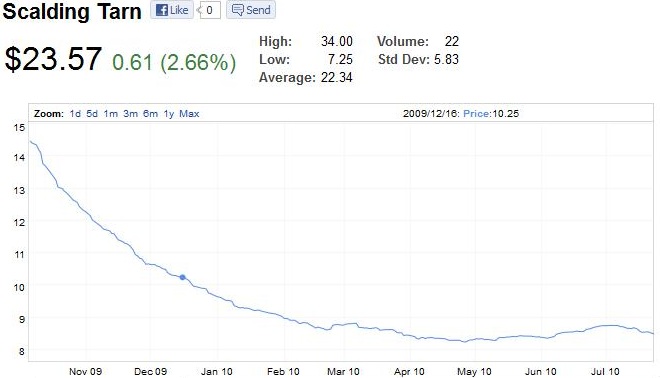
Did all the Zendikar fetchlands behave similarly? Well, here’s the chart for Marsh Flats:
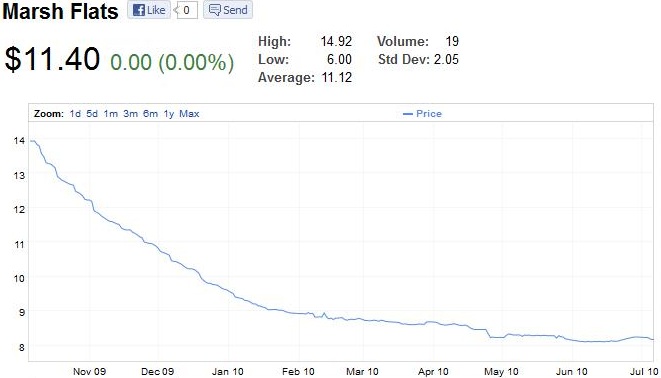
The best time to buy fetchlands would have been late spring/early summer the year after release.
Of course, you can’t ignore the other factors that might come into play with shocklands. There were only five fetchlands total, and Zendikar was drafted through the end of spring. There are about to be five more shocklands printed in Gatecrash, and we’ll soon stop drafting Return to Ravnica. What will that do to the market?
Unfortunately, The Black Lotus project doesn’t have data going back as far as the original Ravnica block. I would have liked to see where these lands settled the first time around. I seem to recall, though, that they didn’t really fall below $15 until after rotation. Of course, that was in the pre-mythic era, so the comparison there isn’t all that great either.
What about the Innistrad lands? When should you have bought those?
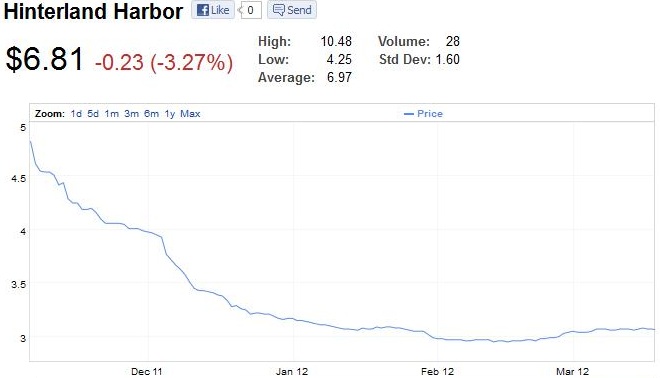
Huh. That’s a very, very familiar pattern. What about the Scars of Mirrodin lands?
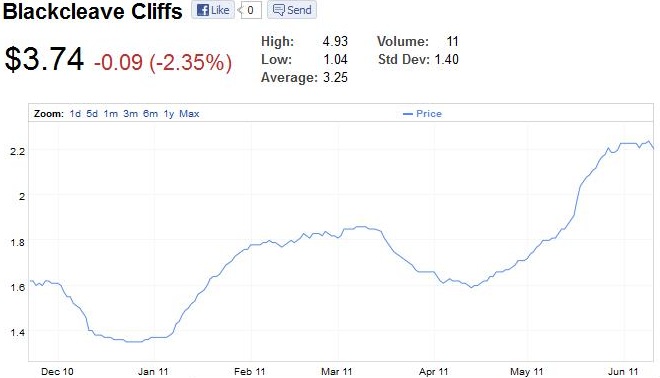
These follow a very different trend, but that’s mostly because they were considered financially irrelevant for the first year of their printing. You could pretty much pick up any one of these lands for a buck or two at any point during late 2010/early 2011. I don’t think you can compare that situation with this one.
So where does that leave us? Personally, I don’t feel like we’ve hit bottom yet. At some point in the next two to three months, there will likely be a chance to buy these lands in the $8-$10 range. If that savings of $8-$10 a playset is important to you, I’d hold off buying them now.
That said, I still expect these lands to be $10-$20 long term, so buying in now isn’t bad per se. A lot of times when I trade, I end up struggling to find something decent to target when my partner is after $30-$40 worth of hard to move casual stuff that I’d just as soon cash out on. These lands are fine pickups at current retail in deals like that because they have a hard floor at $8 and a high velocity.
Birthing Pod & Lotus Cobra
I am going to address both of these in tandem because they are both interesting in similar ways. Both cards see a reasonable amount of play in Modern—Lotus Cobra was in the deck that won the last GP, and Birthing Pod was in the deck that finished second. Both have a decent amount of casual appeal, though neither is outstanding in Commander. Both cards are post Shards block, meaning they won’t be reprinted in Modern Masters. Lastly, neither card has gone up in price from its post-rotation lull. Lotus Cobra is still sitting at $5, and Birthing Pod is stuck at $2.50. If you are looking for a relatively risk free pickup without breaking the bank, here it is.
Why haven’t these cards gone up in price already? The answer is twofold.
First, both decks require an investment in other more expensive cards. The Lotus Cobra deck needs a set of Tarmogoyfs and some Dark Confidants. The Pod deck is much cheaper, but even that one needs a set of Misty Rainforests. Cheap cards in decks that already rely on expensive cards have limited growth potential.
Second, Modern still hasn’t caught on as a casually competitive format. People who PTQ every week need to play the format of course, but the FNM crowd, who often trade for a card simply because they may have a use for it someday, hasn’t quite embraced it yet. When they do, the price for these things will start to go up.
Rhox Faithmender
If you don’t know why this card is amazing, go check out LSV’s Omni-Door Daily Event video. Honestly, that video should be required viewing for anyone who has ever loved Magic. There’s something glorious about a deck with a late game that’s entirely off the wall.
The reason this card is good, quite simply, is Thragtusk. At least a third of the Standard metagame right now is just trying to kill you as fast as possible. Dropping this dude and then gaining ten life off a Thragtusk makes that very, very difficult. Dropping two of these and then gaining twenty off a Thragtusk is unreal. There are so many great things to do in the late game right now—including Sphinx’s Revelation, which also combos with this card. Life gain has never been better.
Even though this is a sideboard card, it is better in multiples. I don’t see it dropping below its current $4 price tag, and it should remain a player in the metagame as long as Thragtusk is still good.
Jace, Architect of Thought
To mix metaphors, the artist formerly known as the most expensive card in Return to Ravnica has left the building. When last we saw Jace 4.0, he was palling around with Tamiyo as a four-of in a sweet U/W shell. That was a while ago, though, back before those decks decided to splash red and go all Staticaster on us. Who would have guessed that this card would be worth less than Sphinx’s Revelation? (It is—$18 to $20.)
As an aside, my biggest problem with the Jaces is that it’s very hard to nickname them. Calling Jace Beleren ‘Little Jace’ is okay, and calling Jace, the Mind Sculptor ‘Jace TMS’ or ‘better than all’ or something is fine. Jace 3.0 is where it gets tricky. I want to call him ‘Brain Jace,’ but then I remember that ALL of the Jaces could be nicknamed Brain Jace, so that doesn’t work. And don’t get me started on Jace 4.0—have you ever tried to spell the world ‘architect?’ Not as easy as you thought, is it? Maybe I’ll just call him Ted Mosby.
Anyway, this guy’s floor is in the $8 range, which is what Brain Jace is currently selling for. Ted Mosby is a ton better than Brain Jace, though, and I still think he’s going to make a resurgence at some point. Sorin, Lord of Innistrad is up to $25 now, and the Architect of Thought sees marginally more play than he does. While I wouldn’t speculate on this guy at $18, I wouldn’t be scared to trade for copies at $15 if the opportunity arose. He’ll be $25+ at least once more before his day in the sun is through.
Bonus Round: Casual/Commander Cards I Like As Long-Term Pickups
- Asceticism – $2.50
- Consecrated Sphinx – $5
- Gilded Lotus – $3
- Grave Titan – $5
- Nicol Bolas, Planeswalker – $4
- Niv-Mizzet, Dracogenius – $3.50
- Omniscience – $4
- Parallel Lives – $4
- Rite of Replication – $2.50
All of these cards are very popular in casual formats and are especially good in Commander. They’re all cards from recent sets that are easy to snag in binders as trade fillers or in exchange for cards that are heading down in price. I would be shocked if every card on this list didn’t double in price over the next year or two.
Until next time–
–Chas Andres



